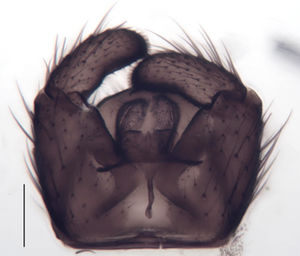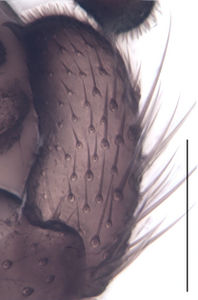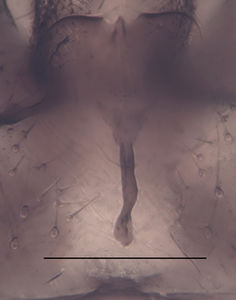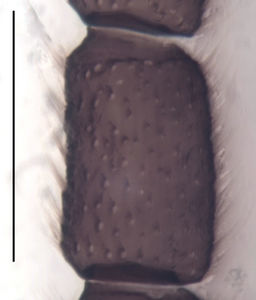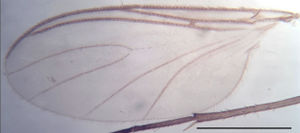Trichosiopsis kathrinae
Ordo: Diptera
Familia: Sciaridae
Genus: Trichosiopsis
Name
Trichosiopsis kathrinae unpublished
Type material
Holotype: ♂, 18.4.–2.5.2013, Malaise trap, leg. Rulik et al., ZFMK-TIS-2564688 in ZFMK
Type locality
Germany, Rhineland-Palatinate, Winningen
Barcoded material
| Stadium | Country | Province | Locality | Habitat | Method | Date | Collector | Collection Number | Collection | Latitude | Longitude | Elevation (m) |
|---|---|---|---|---|---|---|---|---|---|---|---|---|
| 1 ♂ (holotype) | Germany | Rhineland-Palatinate | Winningen | Wald | Malaise trap | 18.4.–2.5.2013 | Rulik et al. | ZFMK-TIS-2564688 | ZFMK | 50.32 | 7.493 | 248 |
| 1 ♀ | Germany | Rhineland-Palatinate | Niederzissen, Bausenberg | Trockenrasen | Malaise trap | 9.4.–24.4.2014 | Rulik et al. | ZFMK-TIS-2564788 | ZFMK | 50.465 | 7.222 | 321 |
Other material studied
Germany: 1 ♂, Baden-Württemberg, Sandweier, Niederwald, Huteeichen im Sandrasen, Malaise trap, Doczkal, 1.-13.05.2006, PKHH 5206; 2 ♂, Rhineland-Palatinate, Kirchheimbolanden, NSG Albertskreuz, Malaise trap, Doczkal, 23.5.-07.06.2002, PKHH 4886/4896[as Leptosciarella zanti (Heller 2012[1]: 93)].
Description (male)
Head. Eye bridge 5–6 rows of facets. Antenna unicolour. LW-index of 4th flagellomere 1.45–1.7; neck 0.17–0.23 × segment width; transition of basal part to neck pronounced. Colour of neck unicolour. Antennal setae shorter than segment width; fine; dense; salient. Palpus darkened; of normal length; palpomeres 3. First palpomere of normal shape; with only sparse sensilla. Second palpomere short and oval. Third palpomere as long as first. Thorax. Colour brown. Notum unicolour. Thoracic setae long and strong; of different colours. Posterior pronotum setose. Postpronotal setae 4–6; fine. Mesothoracic sclerites bare. Legs. Colour yellow-brown. Hind coxa of same colour as femora, or darkened. Setae on front coxa pale. Front tibial organ as patch of setae; dark; front tibial organ not bordered. Tibial setae on hind legs normal, shorter than tibial width. Tibial spurs of equal length. Claws untoothed. Wing. Wing slightly darkened; of normal shape. Wing membrane without macrotrichia. Wing venation weak, with faint stM. M-fork of normal shape. R1 ending at or slightly before base of m-fork; posterior veins with macrotrichia; stM with a few macrotrichia; CuA1 and CuA2 mostly with macrotrichia; bM bare, or setose; r-m mostly setose; bM:r-M 0.8–0.95; st-Cu:bM 0.12–0.22; R1:R 1.05–1.25; c:w 0.61–0.71. Halter darkened; of normal length. Abdomen. Abdominal setae strong; dense; on tergites dark and pale; on sternites white. Hypopygium concolour with abdomen; LW-index 0.63–0.73. Base of gonocoxites with weak setae; gonocoxites narrowly separated; inner margin of gonocoxites typically U-shaped; inner membrane of hypopygium scarcely setose, or densely setose; ventral margin of gonocoxite with short setae. Gonostylus elongate; LW-index 2.55–2.77; Inner margin concave; apex equally rounded. Apical tooth present; without internal structure; of medium strength; LW-Index 1.3–2.1. Awl-like setae normal; beneath apical tooth absent. Megasetae absent. Whiplash-hair absent. Tegmen 0.48–0.58 × longer than broad; rectangular with rounded edges; without special features; central process absent. Length of ejaculatory apodeme/hypopygium 22–28 %; base of ejaculatory apodeme present. Field with aedeagal teeth inconspicuous. Measurements. Body size 2.8–3.5 mm. Hind tibia 1.1–1.6 mm. Wing length 2.7–3.5 mm.
Diagnosis
Trichosiopsis kathrinae is related to Trichosiopsis pilosa and to Trichosiopsis trochanterata by the apically rounded gonostylus and the scarcely setose hypopygial base. It is characterized by very short antennae and mostly pale body hairs on the first abdominal tergites. The most similar species is Trichosiopsis zanti by the shape of the gonostylus. However, the antennae are shorter in Tr. kathrinae and the body size is larger. The colouration of the legs differs between both species, as the hind coxa is apically darkened in Tr. kathrinae and the fore leg is yellow-brown, whereas both is shiningly yellow in Tr. zanti. The bright body hairs on the first abdominal tergites (when present in Tr. kathrinae) are another distinguishing character between both species.
DNA Barcoding
The COI sequence is assigned to BIN BOLD:ADA7967 (average distance 0.31%, max. 0.31%, n=2, K2P: 10.77%).
Etymology
The species is named after Kathrin Wolff-Deines, Kai Heller´s head of group at comdirect, who always supports his studies on Sciaridae with a friendly and tolerant attitude.
Discussion
The finding of Trichosiopsis kathrinae demonstrates, that even species, which were only recently described, but without having made use of DNA barcoding, may result to be species complexes. Paratypes of Tr. zanti from Rhineland-Palatinate Heller (2012)[1] indeed belong to Tr. kathrinae.
Distribution
Germany.
Images
|

